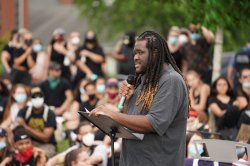What Needs to Change?
Social justice expert Jason Williams discusses the underlying systemic issues that create an environment in which Black people die at the hands of police
Posted in: Faculty Voices, Homepage News, Humanities and Social Sciences

The recent deaths of George Floyd, Breonna Taylor, Tony McDade, and Rayshard Brooks have caused worldwide demonstrations and a universal call for change.
Assistant Professor of Justice Studies Jason Williams, who teaches courses on policing, the Black Lives Matter movement and state violence against women of color, says that while these violent incidents may serve as catalysts, until the systemic and societal issues affecting Black Americans are dealt with in a meaningful way, lasting change cannot occur.
“We must commit to fixing the root problems,” he says. “Only then will we see true change, because every aspect of our environment must evolve in order for these tragedies to cease.”
Socioeconomic issues still remain
Williams explains that the same issues plaguing inner cities for decades still largely remain.
Underfunded inner-city schools create educational inequities that largely affect African Americans. Lack of access to quality, affordable health care has caused African-American men to currently have the shortest life expectancy of any demographic, and African-American women face the highest pregnancy-related mortality rates while those numbers are falling overall.
These and other systemic issues such as income inequality help set the stage for a dangerous environment where the community is already on edge, says Williams.
“Our communities are aware of these statistics,” he says. “They not only have an impact on our day-to-day lives, but also in our interactions with others. The inequalities with which African Americans are saddled stack the deck against them from the outset, and create an inherent sense of mistrust towards anyone that is different or in authority – particularly law enforcement.
“All of these issues contribute to creating communities in which people feel left behind or overlooked entirely – that is, of course, until it comes time to uphold the law and determine which areas need more attention. Then, Black communities are at the front of the line.”
Police training and hiring also play a role
In addition to systemic issues holding many communities of color back, Williams says, police often treat the inner cities like war zones. While police officers are trained to serve and protect, they are also “trained to be warriors and remain disconnected from the very communities they have sworn to keep safe.”
“If officers are socialized and trained to see certain people as the dangerous classes, and they know that the system and the rest of society agree with that depiction, then they know they may do as they please with these groups in terms of use of force, and the evidence bears this out historically,” Williams says.
Because of this mentality, he says, measures to provide training on race relations and creating diverse police forces through hiring have proven unsuccessful.
“Police have long received training on race, yet we continue to see Blacks as disproportionate victims of police misconduct and murder,” says Williams. “Additionally, hiring for diversity is not the antidote because police culture has a damaging effect on the well-being of many minority officers. They often succumb to that culture or leave the profession altogether, which certainly does not aid in solving these issues.”
Why community policing hasn’t worked
Community Policing, a law enforcement strategy originated in the 1960s, is designed to integrate police into neighborhoods by creating partnerships and strategies with local agencies designed to reduce violence and crime.
Williams states, however, that it’s where – and how – agencies choose to deploy this tactic that has created an inherent distrust within the African-American community.
“Community policing, for many in urban neighborhoods, is tantamount to occupation, and has added to a sense of over-policing,” he says. “Crime occurs in other geographical spaces that have a majority white population, too, and those spaces don’t have it. Thus, policing strategies are essentially racialized and often hidden under the guise of geographical issues.
“This creates an immediate lack of trust within the community, because they know community policing isn’t happening everywhere. The result is a disproportionate level of surveillance and arrests within black communities, and incidents like those have recently occurred.”
A starting place
All of these factors have been created in a way that does not serve the African-American community, says Williams, but the most important aspect of each of them is that the community was never consulted – or even considered – during their creation.
“I like to refer to all of these measures as ‘technocratic,’” he says. “The Black community has never been asked in any significant fashion what they want or need from policing. Blacks continue to be treated under the lens of paternalism, and until our voices are truly heard as a partner in creating policy, unfortunately, George, Breonna,Tony and Rayshard will not be the last to fall victim to their environment.”
